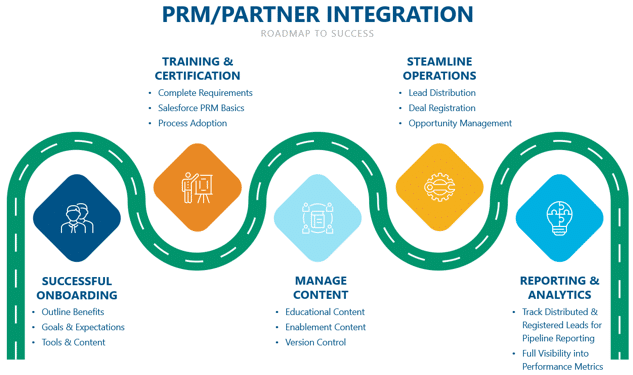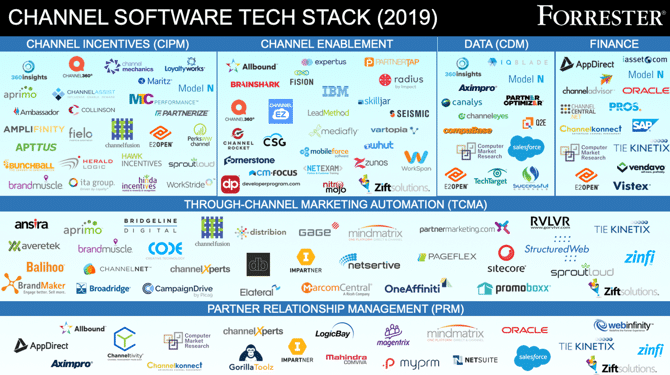Why Your Channel Program Needs PRM (Partner Relationship Management)
What is Partner Relationship Management (PRM)?
When seeking new and innovative opportunities for gaining traction in the marketplace, companies often establish channel partner programs. To create, manage, and maintain these channel partner relationships, partner relationship management (PRM) utilizes strategies and software that help companies execute new marketing ideas, reach new customers, and scale quickly. Creating and implementing a PRM program powered by technology will enhance and streamline your current and future channel partner relationships. Forrester says PRM “connects the dots between partner planning, recruitment, onboarding, enablement, incentives, co-selling, co-marketing, and management.” Simply put, the easier you make your channel partner’s job, the better the results will be.
PRM Strategy: Setting Your Channel Partners Up For Success
Collaboration with channel partners is key to effective PRM implementation. Along with clearly defined expectations and frequent communication, here are some strategic points to consider when crafting your PRM program and developing a roadmap to success.
On-Board, Train, and Enable Your Partners
A PRM platform will ensure you have all the training and enablement content your channel partners require for success. You can create a repository for quick access to training documentation, videos, datasheets, and other supporting materials. Be sure to include a dedicated sales support with new product orientation, go-to-market strategies, and targeted marketing materials. Almost every partner relationship is different, so encourage self-guided training and create personalized experiences for optimal outcomes.
See Leads and Opportunities
PRM technology provides a far more strategic way to track and nurture your pipeline than traditional methods. We have heard a very specific client concern many times over, “I can’t track deals from or distributed leads to partners, and I don’t know how effective they are with their pipeline.” With PRM, channel partners can register their deals, providing visibility into every stage of each lead or opportunity. You can also distribute incoming leads or current opportunities to your partners and inform them about customer requirements, dependencies, or other pertinent information. This helps to enhance sales operations and reduce channel conflict around ownership or incumbency— essentially making it easier for you and your partners to track business activities.
Improve Data-Driven Decision Making
PRM platforms remove channel partner relationship assumptions by not only tracking sales activity but by giving you and your partners the data needed to make intelligent business decisions. You’ll have the ability to analyze, produce, and visualize performance metrics in custom dashboards around short-term quotas and long-range goals, along with real-time reporting that can show what content and resources are most popular and effective. Also, with the ability to capture insights from idea submissions, you can improve both marketing and sales initiatives. And, as PRM platform collaboration newsfeeds help consolidate dynamic conversations, you’ll have more effective communication—and fewer emails.
PRM is a collaborative process, and the more support you can give your channel partners, the more successful they will be. This useful Community Cloud Partner Relationship Management (PRM) Canvas from Salesforce can help with an initial deep dive into your PRM program discovery. You can also reference this high-level PRM/Partner Integration – Roadmap To Success we use at MODintelechy to help clients implement and scale their PRM programs and positively impact the success of their channel partners.
PRM Software
In order to successfully implement what we’ve outlined so far, you will need to have PRM software. Designed to devise strategies, provide functions that control joint sales activities, and ensure effective execution of your channel management strategy, PRM software enables integrations with CRM, ERP, and marketing automation applications to allow you to do so with ease. Using one consolidated platform means partner managers can remove redundant workflows while optimizing and automating essential tasks. They also help build channel collaboration and empower your partners to drive channel revenue and improve overall brand image. PRM software is usually cloud-based and can include a variety of tools and options (we covered a few in the strategy section), and while every partner program has its differences, most PRM software includes the same core functionality and capabilities:
- Integration with CRM and ERP
- Centralized partner portal
- Automated partner onboarding
- Partner incentive creation and analytics
- Deal registration, trial licenses, and demo support
- Automated lead distribution with optimization and scoring
- Forecasts channel sales and analyzes which partners are most effective
- Channel marketing automation
- Document management and co-branded collateral
- Distribution of marketing and sales support material
The PRM software you choose should reflect the specific partnership strategies you choose to pursue. If you’re, say, already using Salesforce CRM and want to prioritize seamless integration and a streamlined user experience, choosing Salesforce PRM would make sense for your company. Of course, selecting PRM software is an important decision and a significant investment you should put some thought into. Here are just a few software options as illustrated by Forrester:

 Back
Back  Cal Cavness
Cal Cavness 






